Sponsored Listings:
Growing up food was a necessity, not a pleasure. It comes as a surprise to people I’ve met on my travels, since my state of mind now is one of pure joy when learning about a new meal. I remember telling a friend in 2002 that planning around food seemed like an extraordinary waste of time. He is quick to remind me now of my statement, and laugh that my readers must think I was a toddler who fiddled around in the kitchen. The reality is that I was a late food-bloomer. When I was preparing to quit my job to take a travel sabbatical in 2008, eating options did not factor into my itinerary. Instead, I started to care about food when I fell headfirst into a world of street eats and roadside chaos. It became apparent that eating was why I wanted to keep travelling. I stood in bustling markets and a sea of carts and soups and tastes that astounded me and thought, “yes, this is what it’s all about.” Food was the most intensive and rewarding lens I could use to learn about a new place, I decided. The next logical step was: how do I eat street food without getting sick?
“Ok,” I said to myself, “rule number 1 is do not eat your favourite animal.”
There were other times I did get sick, blatantly disregarding the book’s advice. But eating street food was not usually the culprit, and it pains me when people avoid street eats thinking restaurants are safer. An acquaintance got sick in Chiang Mai recently and said, “but I didn’t even eat the street meat”. I shook my head in dismay. “That’s probably why you got sick!” Instead, he went to a tourist restaurant during off-peak hours. Two strikes against his stomach right there.
As a strong proponent of eating the street, I wanted to put together a post about how I avoid getting sick from food as I travel. I realize people are worried about food poisoning, and the advice out there does seem to suggest restaurants are safer. I strongly disagree, with some caveats. Once you know what to look for, pay attention to what locals eat and when, then you are on your way to successful, delicious meals that serve as experiences as well as dinner.
No advice is a fail-proof method, but this is what has worked for me.
My tips: eating street food without getting sick
I always put my head in my hands when people say “I am going to Thailand but don’t worry I won’t eat the street food.” I prefer street food for many reasons, but partly because I can see what is happening. When I go to a restaurant I don’t know what the kitchen looks like, and I certainly don’t get to see the base ingredients they are using. Better the kitchen I know!
In my years of travel, I have had some spectacular mishaps. Falling off a motorbike when a truck full of cabbages rained vegetables down on me, bronchitis, lung damage, a broken toe, and dengue. Not all at once, mind you. But certainly difficult, even when spaced out. Food poisoning, however, was very rare. In my 7.5 years of travel at the time of writing this post, I have gotten food poisoning a handful of times. The most recent time was when I ate a yoghurt at the 7-11 in Thailand in 2011. That’s right, I have not gotten food poisoning since 2011 despite eating street food all the time. This feat includes street food in India during my 2013 trip there. I have celiac disease, so if I do feel sick from the food it’s often a gluten issue — joint pain, mood dips, stomach trouble for the first hours. I can spot the difference clearly: no hugging the toilet for the long haul since 2011, and glutening passes quickly — no pun intended.
Over the years, I gathered some tips for eating safely and you have since asked me for more. My book, The Food Traveler’s Handbook, was born from these questions. My goal was to demystify street eats for skeptics, while also providing advice for using food as a way to learn and connect. But I never wrote some tips out on my blog and I thought it was high time I did. The longer version — including why food matters as you travel — is in the book.
1. Check out the lineups.
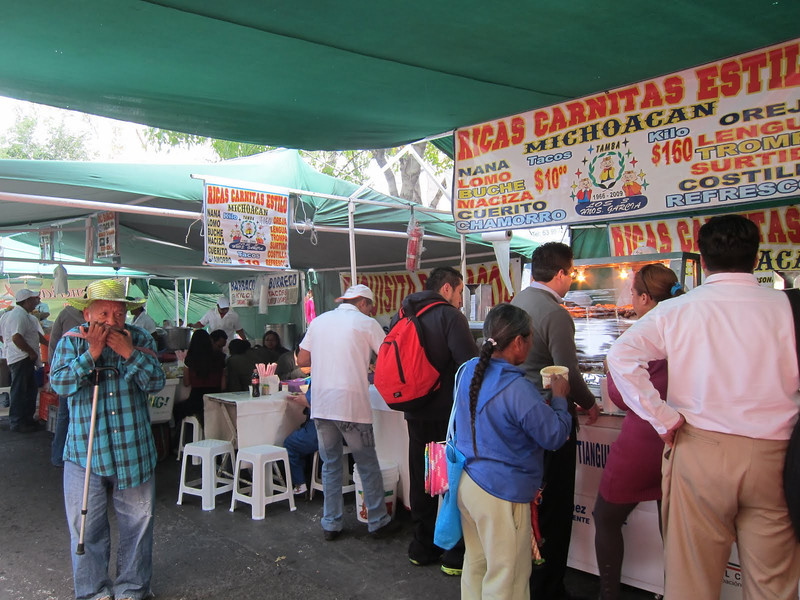
Mexico City food stalls at lunchtime
Everyone tells you to eat at the stalls with the longest line of locals. This is still good advice! But I always add that it’s important to look at who is in line. I know my stomach is potentially less resilient than that of a taxi driver used to quick street meats, so I try to opt for street stalls with both women and children in line.
More variety in the customer base usually means the stall has been vetted enough that it’s safe for everyone. Yes, it’s still better to choose a long lineup of men over crickets and an empty stall, but given the choice, women and children in line is where you want to go.
2. Go back to school at lunchtime
For a cheap lunch, go to the local university and find a place nearby to eat. Students are a hungry bunch, and often some of the fun variations of east meets west pop up here. In Saigon, “pho burgers” were present but so were cheap stalls that served local favorites to a rotating cast of students. It won’t be the best meal of your life, but it will be local, fast, cheap, and usually delicious. Not recommended for dinnertime, however, as the meals will have sat out for the afternoon.
3. Transparent kitchen FTW
As I said in the introduction, I feel like I have more control with a street stall because I can see how the food and the money is handled. If someone is touching the money and then the raw ingredients, I don’t eat there. If there are plastic gloves for the food-making and then they are kept on for handling money? Same – it’s a miss. For two-party stalls often one person will be in charge of the cash and cooking, and the other preparation. This is a good bet, since they are kept separate.
Basically, avail yourself of your senses when choosing where to eat.
That’s not to say that I avoid restaurants entirely! But where there is a culture of street food (like Mexico City or Saigon or Bangkok) I will usually eat all of my meals on the street.
If you are heading to Saigon, my Saigon Street Food Guide will give you a good overview of where to eat in the city.
4. Translation cards for those with food restrictions
I have celiac disease, and another reason I eat on the street is that I can modify the meal as it is cooked, instead of relying on pre-made sauces that might get me sick. I have carried translation cards with me to indicate what I can and can’t eat in the local language. Friends with peanut allergies do the same on their travels through Asia, and of course due diligence is needed to know what ingredients have to be avoided. (In my case, soy sauce, which contains wheat flour.)
Two options for printable cards are Select Wisely or Allergy Translation. They go a long way toward getting your point across — certainly more so than my initial “gesture feverishly while mimicking getting ill over food” — and Select Wisely has a strongly worded option for those with more life-threatening allergies. You could also bring a Point It Dictionary if you’re concerned about eating food you can’t place. Also fun for trading words in your respective language when on a long train ride. I am also in the process of building my own celiac cards with highly detailed notes tailored to specific countries.
If you are a celiac and want to travel safely while avoiding foods that harm you, please see my gluten free travel guides.
5. Cutlery as culprit
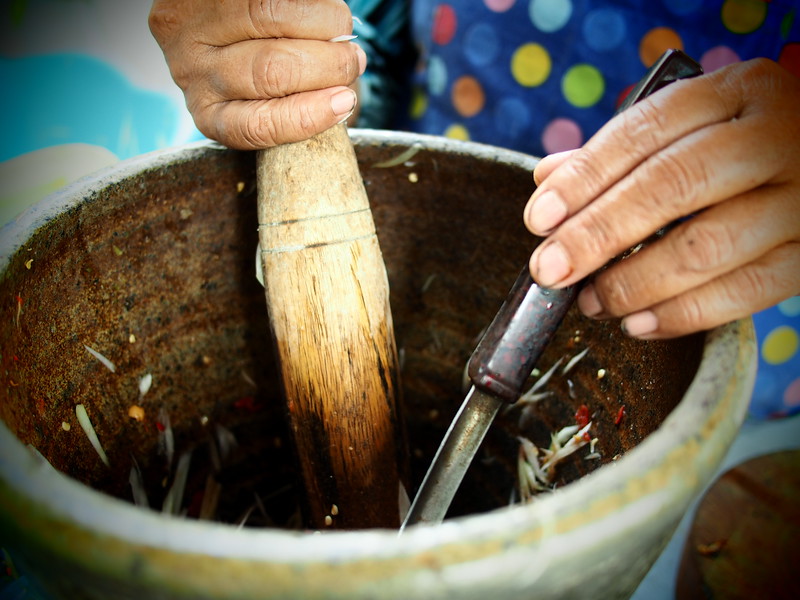
Watching how the cutlery is washed is important.
Cutlery can be a source of bacteria even if the food is safe and fresh. I carry baby wipes with me for older wooden chopsticks that look like they need a wipedown, or for utensils that don’t seem well-washed. It will get you some weird looks but it can be helpful to ensure the cutlery is clean. Alternatively, cute portable chopsticks will do the trick. I carry these ones at all times.
I rarely make use of this extra cleaning-or-chopsticks system but have found it really useful to have the option, especially when outside of urban centers. A bonus: if you need to use the washroom and forgot toilet paper you always have your baby wipes!
6. Morning markets to start the day
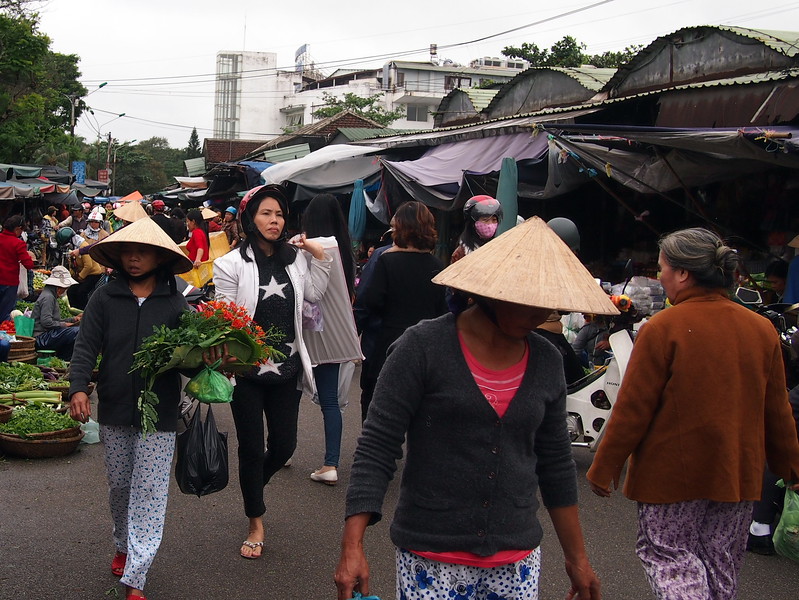
Hue’s Dong Ba market in the morning.
When readers write about where to start with street food, I always suggest they head to a busy local produce market. Be it the many rotating markets around Inle Lake in Myanmar to morning food markets in Mexico City, or on a side trip to a small village — if it has a produce market, it usually has some freshly cooked food. Because these stalls are set up to feed the hungry shoppers, there is quick turnover. I’ve found that a way to experience a daunting new food spectrum is to start at these markets and try the foods one by one.
Plus, many people opt for hotels with breakfasts included, or for a more Western breakfast of yoghurt and fruit. While that may be an option, I’d highly recommend dining at a market instead. If you love the food you try, you can ask the vendor where they are during the day, or if they don’t serve that food elsewhere, where they would suggest you try it instead.
All in all, markets are an excellent way to kickstart your tastebuds and all of your other senses.
7. Follow local meal times
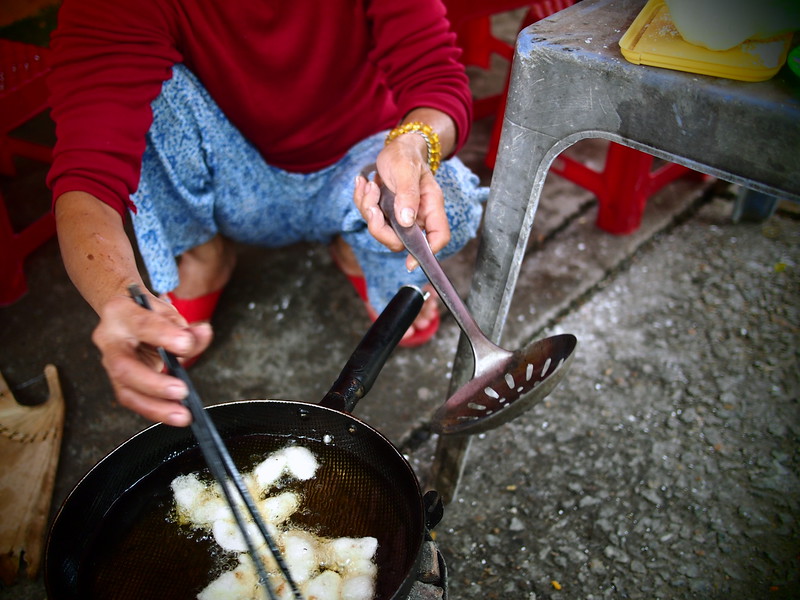
Street stalls move around as people do; eat when the locals eat!
One of the pieces of advice I give to tourists, especially European ones who eat a bit later than North Americans, is to try to mimic the local food times for their meals. I realize that 6pm dinners or 11am lunches don’t fit the usual meal patterns for most, but it can be very helpful for your stomach if that’s when locals eat.
This is especially important when dishes are cooked and set out buffet style, as you’d want to eat them when they are fresh and before bacteria can form as the food cools. For me, this means shifting my meal times somewhat but it is worth it because the food is piping hot, newly cooked, and doesn’t get me sick.
8. Fully cooked food is safest
Remember my llama empañada? Yup, I disregarded this advice entirely. The center of the snack was cold and I still finished it off. DON’T BE ME. If it’s not fully cooked and it’s supposed to be a hot meal, ask for it to be cooked a bit more.
I’ve gotten more adventurous over the years, eating raw shrimp dishes in Thailand and fresh herbs in places where I don’t know the water source. This has been a product of my own risks and my understanding of what my stomach can handle. Happily, even in North India I didn’t get sick, despite eating street food. Why? I made sure it was fully cooked, freshly made, and my mum and I also decided to stick to the meal times of locals. (I have to say I was a bit surprised as I anticipated getting sick at least once given the stories of my friends but happily I did not!)
9. Beware of ice or fruit shakes where water is contaminated
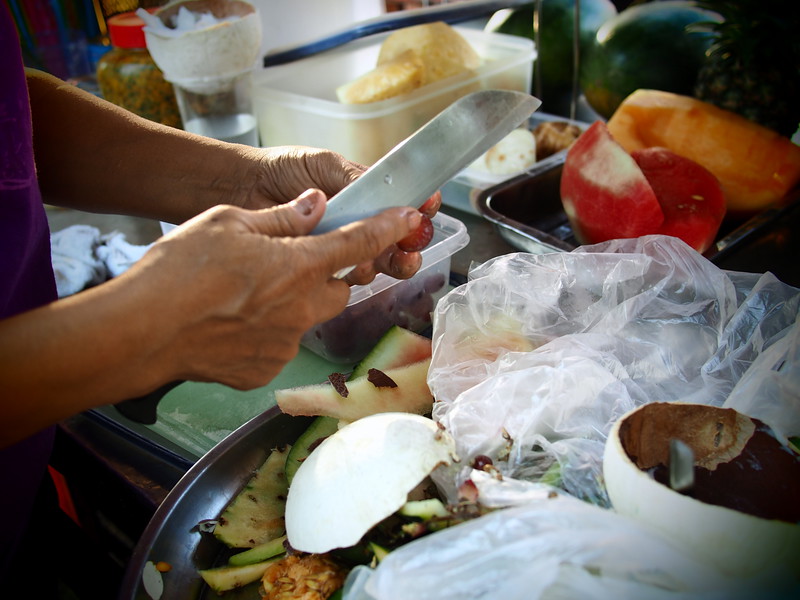
Paying attention to how fruit shakes are made goes a long way! Mrs. Pa in Chiang Mai uses safe water and safe ice.
I order drinks with ice in Saigon or Bangkok, where filtered water is subsidized and available cheaply for the general population. I’ve also spent quite a bit of time in both cities and have never gotten sick from the water or ice. That said, when I travel outside the cities I try to avoid ice or fruit shakes with ice because I do not know how the ice was made. If there’s an easy thing to cut out where the water isn’t safe, ice is the first to go. Fruit shakes in Laos downed quite a few of my friends because the ice was not made from distilled water. Best to be sure, especially if you’re frequently on the move.
10. Vegetarian for a spell?
In some destinations, I avoid meat if I am really concerned about food poisoning. When I took my mum to India, we ate street food but stuck to vegetarian eats for the most part. The times we did eat meat we were told we were taking a risk, but we decided to regardless because we were excited about the food. Even the most carnivore of friends tend to temporarily avoid meat in places where water is extremely contaminated.
11. Peel your fruit or don’t eat it

Rambutan, the “hairy fruit”, in Vietnam. These are easy to peel and great as a snack.
Unless you are used to a new place and its bacteria, I would only eat peelable fruit. Bananas, papaya, mango, rambutan, mangoesteens and more — there is no shortage of delicious fruit that has a peel, and your stomach will thank you. Avoid lettuce, or fruit with skin you eat (like apples). Strawberries, while tempting, ought to be avoided in countries with high pollution and a questionable water system.
12. Sauces can be a problem
I love a good table condiment, but occasionally the sauces are what causes travelers some distress. The reason is that in many destinations they are kept at room temperature, meaning they can breed bacteria over time. I tend to gauge my sauce usage on the amount of consumption from other diners: if it’s a food where condiments are used liberally (e.g. bun rieu soup in Vietnam, where it would be blasphemous to skip adding wet chili paste), I go for it. If I can see crust on the side of the sauce, or a few drops are used at a time, I will take my time trying the salsas or sauces to ensure they are not unrefrigerated indefinitely.
I am currently in Oaxaca, Mexico, and I have eaten sauces for all my meals thus far without issue. I have also chosen places teeming with people and families, and watched almost everyone scoop liberal amounts onto their food.
What if you do get food poisoning?
The tips above are not guarantees and even the most iron cast stomachs can be felled occasionally by a food misadventure. It is part and parcel of the risk inherent in traveling.
If you get food poisoning or a stomach illness, then a visit to a local doctor might be in order. Many of them are familiar with traveler’s diarrhea but also with any lingering viruses circulating in the region. I do not take Imodium unless and until I have an absolute emergency in the form of a long bus ride plus food poisoning.
I would caution against trying to rehydrate immediately with sweetened sport electrolyte drinks because I’ve found the high levels of sugar in those drinks actually make me feel worse if the bacteria are still in my system. Instead, I stick to a steady diet of oral rehydration salts, rice (bread is a substitute if you are not gluten-intolerant) and bananas. Hydrate as much as possible.
Trioral oral rehyration salts
are recommended by the World Health Organization, but in the event you don’t have them I have never found a pharmacy in my years of travel that won’t stock a version of these tablets in their stores. They don’t taste great but they are important if you do get sick.
For more tips for packing on your travel, see my World Travel Resources Page
I would also recommend traveling with probiotics that don’t need refrigerating. They have helped me get back on track the times I have been sick, and I feel better when I take them. I use the Ultimate Flora 90 billion capsules for women, but the unisex version is here. I realize not everyone is sold on probiotics and that’s fair, but as always I am sharing my experiences. For an overview of pros and cons of probiotics, see this piece by the University of California at Berkeley.
Ultimately, when I am sick is when I feel loneliest as a solo traveler, so I am very grateful for technology that lets me chat with friends no matter where I am!
Resources for food lovers who travel
I wanted to end this post with some of the books and sites I’ve gone to over and over again to further fuel my love of food. The first is practical, the rest are suggested for the beauty of the scenes they conjure in prose and photos.
Books to Read
How to Shit Around the World: a doctor’s advice about staying healthy as you travel, food and otherwise. Written with humor and joy, from someone who has been around the world.
Eating Vietnam: a new book from Graham Holliday, famous for his delightful Noodle Pie blog, on his many incredible meals on the streets of Vietnam. As someone who loves Vietnamese food, especially eating it on those tiny blue stools on the side of the road, this book was just wonderful to read.
Lucky Peach’s Street Food issue: covering Chiang Mai, Mexico City, Mumbai, and Buenos Aires.
The World’s Best Street Food: A large food book from Lonely Planet that doubles as a guide. It talks about the kinds of foods in each street food mecca, how they are made, and their primary ingredients and underlying story, and then provides recipes so you can make them at home.
Heat: I read this book years ago but it remains a huge fave, one of those books I was sad came to an end. It follows Bill Buford’s adventures when he decides to apprentice in Mario Batali’s kitchen, then learns how to be a line cook, a pasta-maker, and an apprentice to a Dante-quoting butcher in Tuscany.
Shark’s Fin and Sichuan Pepper: Fuchsia Dunlop’s memoir of her time eating in China was so lovingly crafted that I could not concentrate until I finished the book. A great insight into not just her travels but also Chinese culture as seen from outside eyes.
Spice: The History of a Temptation: Written by Jack Turner, a Brit with a great sense of humor, this history of spices and the spice trade takes you through the ages and into the minds and palates of explorers from hundreds of years ago to present day.
Salt: A World History: Essential reading from Mark Kurlansky about the history of the world’s most overlooked white powder, and how its use changed the way we function in the world and how much we were able to explore it by sea.
Three Cookbooks I Love
Latin American Street Food: The best flavors from the markets and beaches and roadside stands in Latin America, from Mexico down to Argentina, in recipes you can make at home.
David Thompson’s Thai Street Food: A bible for those who love to eat Thai food, this cookbook combined with travelogue is a must for your shelf. It’s heavy, but you’ll enjoy it.
Burma: Rivers of Flavor: I’ve gifted this book to friends and family alike because Naomi Duguid beautifully captures the colors, flavors, and fascinating history from her many months in Burma (Myanmar).
Food Sites to Learn From
There’s nothing more satisfying to me than learning about the stories and history behind the foods on my plate. Here are a few websites that I turn to time and time again as starting points for these culinary explorations:
Hopefully with this guide you will not shy away from street food entirely, but instead pick judiciously and enjoy not just the explosion of tastes on your tongue but also the glorious chaos of sitting on the street and surveying the scene as you eat.
Bon appetit!
-Jodi
Source: legalnomads.com










